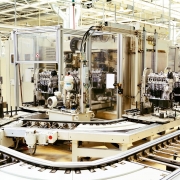Article originally published on September 21, 2020 by Charlotte Gifford for World Finance.
There’s a reason China has been named “the world’s factory”. According to data published by the United Nations Statistics Division, China accounted for almost 30 percent of global manufacturing output in 2018.
China earned this status in a relatively short space of time. According to The Economist, in 1990, China produced less than 3 percent of global manufacturing output. It first overtook the US, previously the world’s manufacturing superpower, in 2010.
But the US-China trade war has prompted many companies to re-examine global supply chains. A recent study by the McKinsey Global Institute estimates that companies could shift a quarter of their global product sourcing to new countries in the next five years. Climate risks, cyber attacks and the ongoing pandemic are only accelerating this trend. In this uncertain trade environment, a growing number of countries are hopeful that they could replace China as the world’s next major manufacturing hub.
Vietnam
So far, Vietnam has been one of the main beneficiaries of the US-China trade war, absorbing much of the manufacturing capacity that China lost. As well as cheap labour and stable politics, the country boasts increasingly liberalised trade and investment policies that make it an attractive place for businesses looking to diversify out of China.
Some of the biggest names in tech have relocated some of their operations to Vietnam since tensions between the two powers soured. In early May 2020, Apple announced it would produce roughly 30 percent of its AirPods for the second quarter in Vietnam instead of China.
Mexico
A lesser-known beneficiary of the trade war is Mexico. In a report, the investment bank Nomura pointed out that Mexico could become a top destination for US companies, with the country having set up six new factories in a range of sectors between April 2018 and August 2019. In addition, Taiwan-based manufacturers Foxconn and Pegatron, known as contractors for Apple, are among a number of companies currently considering shifting their operations to Mexico.
Mexico’s proximity to the US poses a major advantage as US companies embrace “near-shoring”. The Trump administration is exploring financial incentives to encourage firms to move production facilities from Asia to the US, Latin America and the Caribbean.
India
In recent years, India has significantly stepped up efforts to attract manufacturing investments into the country. Prime Minister Narendra Modi’s “Made in India” initiative is designed to help the country replace China as a global manufacturing hub. A cornerstone of this plan involves encouraging the world’s biggest smartphone brands to make their products in India. In June of this year, the country launched a $6.6bn incentive programme to boost electronics manufacturing production in the country.
So far however, the country has seen only modest gains from the trade war. Analysts blame India’s stringent regulatory environment; on the Organisation for Economic Development’s FDI Regulatory Restrictiveness Index, India ranks 62nd out of 70 countries.
Malaysia
Between 2018 and 2019, the Malaysian island of Penang saw a surge in foreign investment. Much of this came from the US, which spent $5.9bn in Malaysia in the first nine months of 2019, up from $889m the year before, according to the Malaysian Investment Development Authority. US chip maker Micron Technology announced it would spend RM1.5bn ($364.5m) over five years on a new drive assembly and test facility.
However, the loss of trade from China has hit Malaysia hard. Many tech firms in Penang rely on China for as much as 60 percent of their components and materials.
Singapore
Singapore’s manufacturing prowess has somewhat depleted in recent years. While manufacturing contributes about 30 percent of the GDP of Taiwan and South Korea, it makes up just 19 percent of Singapore’s.
However, the trade war and the coronavirus pandemic could change this. As a trade hub with liberal trade and investment policies and a history of stable economic growth, Singapore is well-positioned to boost its manufacturing capabilities and capitalise on this opportunity.
However, like Malaysia, Singapore is also struggling with the knock-on effects of decreased demand from China. The export-dependent country has seen its manufacturing output slump as a result of the trade war – a sign that the country could benefit from greater independence from China.


